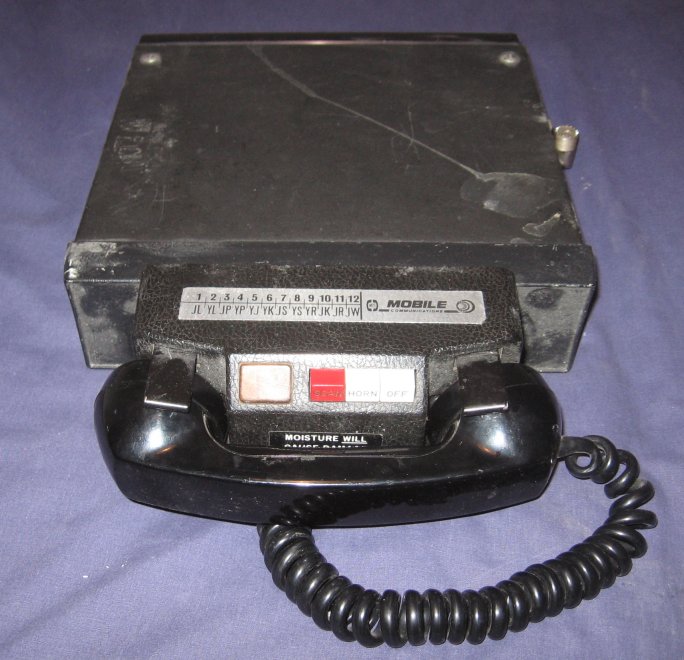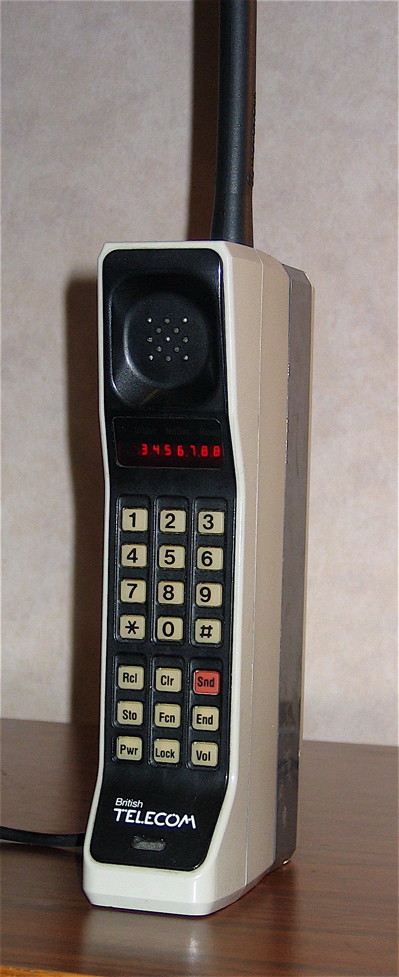|
Improved Mobile Telephone Service
The Improved Mobile Telephone Service (IMTS) was a pre-cellular Very High Frequency, VHF/Ultra High Frequency, UHF radio system which linked to the Public Switched Telephone Network, public telephone network. IMTS was the radiotelephone equivalent of land dial phone service. Introduced in 1964, it replaced Mobile Telephone Service (MTS) and improved on most MTS systems by offering direct-dial rather than connections through a live operator, and full-duplex operation so both parties could talk at the same time. Technical Information The original Bell System US and Canadian mobile telephone system includes three frequency bands, VHF Low (35-44 MHz, 9 channels), VHF High (152-158 MHz, 11 channels in the U.S., 13 channels in Canada), and UHF (454-460 MHz, 12 channels). Alternative names were "Low Band", "High band" and "UHF". In addition to the Bell system (wireline incumbent) channels, another 7 channels at VHF, and 12 channels at UHF were granted to non-wireline ... [...More Info...] [...Related Items...] OR: [Wikipedia] [Google] [Baidu] |
North American Numbering Plan
The North American Numbering Plan (NANP) is a telephone numbering plan for twenty-five regions in twenty countries, primarily in North America and the Caribbean. This group is historically known as World Zone 1 and has the international calling code ''1''. Some North American countries, most notably Mexico, do not participate in the NANP. The NANP was originally devised in the 1940s by the American Telephone and Telegraph Company (AT&T) for the Bell System and the independent telephone operators in North America. The goal was to unify the diverse local numbering plans that had been established in the preceding decades and prepare the continent for direct-dialing of calls by customers without the involvement of telephone operators. AT&T continued to administer the numbering plan until the breakup of the Bell System, when administration was delegated to the North American Numbering Plan Administrator (NANPA), a service that has been procured from the private sector by the Fede ... [...More Info...] [...Related Items...] OR: [Wikipedia] [Google] [Baidu] |
Two-way Radio
A two-way radio is a radio that can both transmit and receive radio waves (a transceiver), unlike a broadcast receiver which only receives content. It is an audio (sound) transceiver, a transmitter and receiver in one unit, used for bidirectional person-to-person voice communication with other users with similar radios. Two-way radios are available in stationary ( base station), mobile (installed in vehicles), and hand-held portable models. Hand-held two-way radios are often called walkie-talkies, handie-talkies or hand-helds. Two-way radios are used by groups of geographically separated people who need to keep in continuous voice communication, such as aircraft pilots and air traffic controllers, ship captains and harbormasters, emergency services personnel like firefighters, police officers, and ambulance paramedics, taxi and delivery services, soldiers and military units, fast food and warehouse employees, and radio amateurs. Two-way radio systems may use a single radio c ... [...More Info...] [...Related Items...] OR: [Wikipedia] [Google] [Baidu] |
Radiotelephone
A radiotelephone (or radiophone), abbreviated RT, is a radio communication system for conducting a conversation; radiotelephony means telephony by radio. It is in contrast to '' radiotelegraphy'', which is radio transmission of telegrams (messages), or ''television'', transmission of moving pictures and sound. The term is related to radio broadcasting, which transmit audio one way to listeners. Radiotelephony refers specifically to two-way radio systems for bidirectional person-to-person voice communication between separated users, such as CB radio or marine radio. In spite of the name, radiotelephony systems are not necessarily connected to or have anything to do with the telephone network, and in some radio services, including GMRS, interconnection is prohibited. Design Mode of emission The word ''phone'' has a long precedent beginning with early US wired voice systems. The term means ''voice'' as opposed to telegraph or Morse code. This would include systems fitting in ... [...More Info...] [...Related Items...] OR: [Wikipedia] [Google] [Baidu] |
Mobile Radio Telephone
Mobile radio telephone systems were telephone systems of a wireless type that preceded the modern cellular mobile form of telephony technology. Since they were the predecessors of the first generation of cellular telephones, these systems are sometimes retroactively referred to as pre-cellular (or sometimes zero generation, that is, 0G) systems. Technologies used in pre-cellular systems included the Push to Talk (PTT or manual), Mobile Telephone Service (MTS), Improved Mobile Telephone Service (IMTS), and Advanced Mobile Telephone System (AMTS) systems. These early mobile telephone systems can be distinguished from earlier closed radiotelephone systems in that they were available as a commercial service that was part of the public switched telephone network, with their own telephone numbers, rather than part of a closed network such as a police radio or taxi dispatching system. These mobile telephones were usually mounted in cars or trucks (thus called ''car phones''), although ... [...More Info...] [...Related Items...] OR: [Wikipedia] [Google] [Baidu] |
Car Phone
A car phone is a mobile radio telephone specifically designed for and fitted into an automobile. This service originated with the Bell System and was first used in St. Louis on June 17, 1946. Overview The original equipment weighed , and there were initially only 3 channels for all the users in the metropolitan area. Later, more licenses were added, bringing the total to 32 channels across 3 bands (See IMTS frequencies). This service was used at least into the 1980s in large portions of North America. On October 2, 1946, Motorola communications equipment carried the first calls on Illinois Bell Telephone Company's new car radiotelephone service in Chicago. Due to the small number of radio frequencies available, the service quickly reached capacity. In Finland, car phone service was first available in 1971 on the zero-generation ARP (Autoradiopuhelin, or Car Radiophone) service. This was succeeded in 1982 by the 1G system NMT (Nordic Mobile Telephone), used across Scandin ... [...More Info...] [...Related Items...] OR: [Wikipedia] [Google] [Baidu] |
Advanced Mobile Phone System
Advanced Mobile Phone System (AMPS) was an analog mobile phone system standard originally developed by Bell Labs and later modified in a cooperative effort between Bell Labs and Motorola. It was officially introduced in the Americas on October 13, 1983,Private Line and was deployed in many other countries too, including Israel in 1986, Australia in 1987, Singapore in 1988, and Pakistan in 1990. It was the primary analog mobile phone system in North America (and other locales) through the 1980s and into the 2000s. As of February 18, 2008, carriers in the United States were no longer required to support AMPS and companies ... [...More Info...] [...Related Items...] OR: [Wikipedia] [Google] [Baidu] |
CB Radio
Citizens band radio (also known as CB radio), used in many countries, is a land mobile radio system, a system allowing short-distance person-to-many persons bidirectional voice communication among individuals, using two way radios operating on 40 channels near 27 MHz (11 m) in the high frequency (a.k.a. shortwave) band. Citizens band is distinct from other personal radio service allocations such as FRS, GMRS, MURS, UHF CB and the Amateur Radio Service ( "ham" radio). In many countries, CB operation does not require a license, and (unlike amateur radio) it may be used for business or personal communications. Like many other land mobile radio services, multiple radios in a local area share a single frequency channel, but only one can transmit at a time. The radio is normally in receive mode to receive transmissions of other radios on the channel; when users want to talk they press a "push to talk" button on their radio, which turns on their transmitter. Users o ... [...More Info...] [...Related Items...] OR: [Wikipedia] [Google] [Baidu] |
Whip Antenna
A whip antenna is an antenna consisting of a straight flexible wire or rod. The bottom end of the whip is connected to the radio receiver or transmitter. A whip antenna is a form of monopole antenna. The antenna is designed to be flexible so that it does not break easily, and the name is derived from the whip-like motion that it exhibits when disturbed. Whip antennas for portable radios are often made of a series of interlocking telescoping metal tubes, so they can be retracted when not in use. Longer whips, made for mounting on vehicles and structures, are made of a flexible fiberglass rod around a wire core and can be up to long. The ideal length of the whip antenna is determined by the wavelength of the radio waves it is used with. The most common type is the ''quarter-wave whip'', which is approximately long, but they can be either longer or shorter by design, varying from compact electrically short antennas wavelength long, up to wavelength to improve direct ... [...More Info...] [...Related Items...] OR: [Wikipedia] [Google] [Baidu] |
Cellular Network
A cellular network or mobile network is a communication network where the link to and from end nodes is wireless. The network is distributed over land areas called "cells", each served by at least one fixed-location transceiver (typically three cell sites or base transceiver stations). These base stations provide the cell with the network coverage which can be used for transmission of voice, data, and other types of content. A cell typically uses a different set of frequencies from neighboring cells, to avoid interference and provide guaranteed service quality within each cell. When joined together, these cells provide radio coverage over a wide geographic area. This enables numerous portable transceivers (e.g., mobile phones, tablets and laptops equipped with mobile broadband modems, pagers, etc.) to communicate with each other and with fixed transceivers and telephones anywhere in the network, via base stations, even if some of the transceivers are moving through more than ... [...More Info...] [...Related Items...] OR: [Wikipedia] [Google] [Baidu] |
Very High Frequency
Very high frequency (VHF) is the ITU designation for the range of radio frequency electromagnetic waves ( radio waves) from 30 to 300 megahertz (MHz), with corresponding wavelengths of ten meters to one meter. Frequencies immediately below VHF are denoted high frequency (HF), and the next higher frequencies are known as ultra high frequency (UHF). VHF radio waves propagate mainly by line-of-sight, so they are blocked by hills and mountains, although due to refraction they can travel somewhat beyond the visual horizon out to about 160 km (100 miles). Common uses for radio waves in the VHF band are Digital Audio Broadcasting (DAB) and FM radio broadcasting, television broadcasting, two-way land mobile radio systems (emergency, business, private use and military), long range data communication up to several tens of kilometers with radio modems, amateur radio, and marine communications. Air traffic control communications and air navigation systems (e.g. VOR and ILS) wo ... [...More Info...] [...Related Items...] OR: [Wikipedia] [Google] [Baidu] |
Co-channel Interference
Co-channel interference or CCI is crosstalk from two different radio transmitters using the same channel. Co-channel interference can be caused by many factors from weather conditions to administrative and design issues. Co-channel interference may be controlled by various radio resource management schemes. Cellular mobile networks In cellular mobile communication (GSM & LTE Systems, for instance), frequency spectrum is a precious resource which is divided into non-overlapping spectrum bands which are assigned to different cells (In cellular communications, a cell refers to the hexagonal/circular area around the base station antenna). However, after certain geographical distance, these frequency bands are re-used, i.e. the same spectrum bands are reassigned to other distant cells. The co-channel interference arises in the cellular mobile networks owing to this phenomenon of frequency reuse. Thus, besides the intended signal from within the cell, signals at the same frequenc ... [...More Info...] [...Related Items...] OR: [Wikipedia] [Google] [Baidu] |







